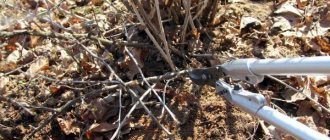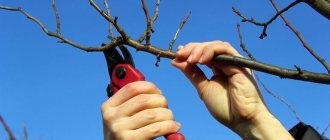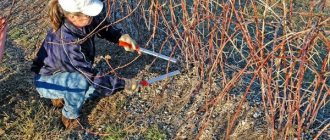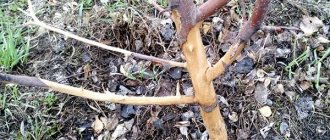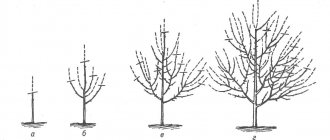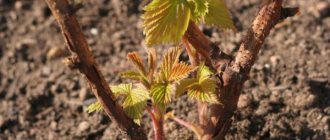Maiden grapes as a garden guest: growth rates, planting, reproduction
Maiden grape is a deciduous tree-type vine from the Grape family. It is also known as virgin ivy due to its ability to self-pollinate. The growing area extends from Asian countries to the shores of North America. There are about 12 varieties of this plant in the wild. Winter-hardy varieties are widely used in landscape design.
If virgin grapes are chosen for the garden, planting and caring for them will not take much time. Due to their unpretentiousness and high frost resistance, wild grapes are actively used to decorate outbuildings, covered benches, gazebos, arches, columns, and plant sculptures. It goes well with different varieties of spirea, weigela, and forsythia. This plant's buds bloom on last and new year's shoots, forming a lush crown in early spring.
Unpretentious liana for garden decor
The description should begin with the fact that virgin ivy is a vine with shoots of dark green and reddish shades. The leaves have a carved shape, they are green in spring and summer, and red in autumn. Color may vary depending on the species and variety.
Green small flowers are collected in paniculate inflorescences of 80-150 pieces. The period of active bud formation occurs in late spring. The fruits are dark blue berries with a diameter of 5 to 8 mm, contain a high concentration of oxalic acid, and are therefore unsuitable for consumption.
Regardless of the variety, virgin grapes have a number of typological features. These include:
- high growth rates and frost resistance;
- ease of care;
- shade tolerance;
- drought resistance;
- does not require additional supports or garter;
- resistance to pests and fungal diseases;
- grows on any soil.
How fast does it grow?
Among the disadvantages, gardeners highlight high growth rates. Specimens growing on fertile, light soils require regular seasonal pruning. With relatively simple care, wild grapes produce significant annual growth and, after a couple of years, are able to completely decorate garden objects. The final growth rates directly depend on the region of growth and frost resistance zone:
- zone 9 (average winter temperature -7°C) – annual growth can be from 270 to 300 cm;
- zone 8 (-12°C) – from 260 to 270 cm annually;
- zone 7 (-17°C) – from 200 to 260 cm per year;
- zone 6 (-23°C) – from 147 to 200 cm annually;
In the wild, it climbs to a height of 20 m, twining around the trunks of trees and bushes to get to the light.
Basic rules for pruning and how to prune grapes in the fall
Regardless of the type of formation that is chosen for the bushes, the height of the trellis or the variety, the pruning rules are the same: last year's wood must be removed and only this year's shoots should be left. For each long shoot (fruit shoot), a short one is left in addition - this will be a replacement shoot (twig). Together, the long and short replacement shoots form the fruiting unit. See the diagram for pruning grapes in the fall for beginners.
Grape pruning scheme by year
Many novice gardeners and winegrowers are interested in the question of how long to trim the fruit arrow. Here you should focus on the growth vigor of the bush, inherent in the variety and its fruiting characteristics. On vigorous varieties (Kodryanka, Strashensky, Alpha, Kishmish radiant) and varieties that bear fruit on distant buds, you need to leave longer shoots of at least 10-12 buds. On varieties that bear fruit on the near eyes (Crystal), you can leave up to 6 buds.
Five-leafed and tripointed species: what to choose for planting?
The plant is not distinguished by its exotic crown color, lush buds and fancy frame. Its main advantage is the exquisite shape of the leaves. Thanks to the carved edge and finger shape, the crown of the vine has a relief pattern. Taking into account the size of the leaf blades, gardeners select a suitable variety for growing on the site.
The following types are popular today:
- five leaf;
- tripointed, having several varietal hybrids with excellent decorative properties.
Five-leaf is native to North America, where it is known as Virginia grape. Adult specimens reach 20 m in length, side shoots grow up to 3-4 m. They tend to become lignified and darken with age. The unpretentious species got its name thanks to its crown. The foliage of the compound type is collected from 5 small leaves planted on a long petiole. Each leaf has a pointed shape with a jagged edge. With the onset of frost, they acquire a noble burgundy hue.
The flowering period of five-leaf grapes occurs in the first ten days of July. However, the exact timing will depend on the region of growth. Inflorescences last from one and a half to two weeks. Umbrellas consist of simple white flowers. After the specified period, the first fruit ovaries appear. The berries ripen by the end of August and are of purely decorative interest.
Triacrimony is an inhabitant of the Far East; it is characterized by high frost resistance and ease of care. European landscape designers dubbed the tripointed species Boston ivy, since its leaves externally resemble the crown of poison ivy. Shoots of wild grapes grow at a speed of 1-1.3 m per month. The crown consists of glossy leaves that have an elongated shape and a tee-shaped ending.
There are several hybrid varieties on sale that differ in color. For example, the Golden variety grows up to 12 m in length, the foliage is decorated with golden-yellow spots. The leaves of the purple variety have purple veins and scarlet pigment.
The 2021 lunar calendar recommends the following dates for pruning grapes:
When the moon becomes waning, it is time to prune the grapes. However, the actual weather does not always correspond to the recommendations. Therefore, initially monitor the weather forecast. It is advised not to prune grapes during the full moon or new moon.
Favorable days of autumn 2021 to prune grapes:
3 – 16 September
from 3 to 15 October
November 1 - 14.
Bad days for pruning
2 and 17 September 2, 16, 31 October 15 and 30 November
We recommend reading the article: Planting grapes: how and when to plant grapes correctly in the fall
Features of pruning in autumn: knowledge and methods of pruning
When pruning grapes in the fall, do not forget to take into account an important nuance. The varieties most resistant to low temperatures are processed initially. Secondary - varieties that do not tolerate winter frost well.
The structure of the grape bush and the necessary terminology
The old vines of the bush are the sleeves or shoulders, or grandmother vines, and the young shoots that grew this summer are the mother vines; berry clusters form on them. On the sleeves the wood is old, thickened, and tends to peel off. Over the summer, the old vine grows young branches on which grape clusters will grow next season. Mother fruit vines grow up to 2-3 m in length per season. But they are cut back to 6-9 buds. Count the buds from the bottom and cut after the ninth. It is better to form the vines to the same length. Don't be alarmed if you get 7 eyes on one branch and 9 eyes on the other. The laying of fruit links occurs on old, lignified strong ones.
What is a fruit link? It is a combination of a replacement knot and a pair of fruit arrows. The replacement branch (twig) is formed at the bottom, close to the head (trunk), the fruit arrow is cut longer and further.
What is a substitution knot?
It is located below the fruiting vine and outward from the trunk of the bush. It is cut off with only 2-3 eyes. How are sleeves renewed, why is a replacement knot needed? A new fruit link is formed from it for the next year. On this branch 2 new branches grow, which form a new fruiting zone. Those. In the fall, the fruit-bearing vines of this year are pruned, and from the grown vines on a replacement branch, a new fruit vine is created with a new replacement branch.
Also, with the help of this knot, you can shorten the length of the shoulder and position the fruiting zone closer to the trunk of the bush. When pruning, 6-8 eyes are retained on the fruit arrows, which will bear fruit. Next season, a shoot will grow from each eye, which will produce clusters. The remaining vines are completely pruned into a ring. However, it is imperative to leave the stumps about 2 cm so that the buds do not dry out. To form a compact grape bush, leave those fruit vines that are located closer to the trunk of the bush. Experienced winegrowers do not always leave a replacement knot. Some do shaping without it. This is also acceptable.
Features of impeccable pruning of grapes in autumn
There is no way for grapes to grow without pruning. The main mistake of inexperienced amateurs is leaving extra vines. What will be the result? The bush will thicken, there will be weak fruiting, small berries and clusters, and the ripening period will be longer. The bush will quickly grow excess green mass if you prune a little more. Before pruning the grapes, you need to charge the bush with moisture. Those. perform moisture-charging irrigation. The bush approximately consumes up to 60 liters of water. In dry autumn it is possible to increase water consumption. Initially prune immature, thin and damaged vines.
The pruning rule says that when an adult bush is pruned, the remainder of it is 1/5, and 4/5 of the vines is considered cut off. For example, if there were 5 fruit vines on a shoulder during the season, then after pruning only one remains. There is also another algorithm. After pruning, 35-40 buds should remain.
For fruit arrows, we choose the thickest and most powerful shoots that are well ripened and woody. Do not forget that in the future we will continue to form the bush, so it is better to choose shoots that are closer to the trunk. Perform pruning from the lower shoots in an upward direction. However, it is also bad if the fruit shoots are formed very low to the ground. If the berries hang very low, they may bend, because will be deprived of good ventilation. After pruning, the bush must be watered and the grapes sprayed against diseases and rodents.
Required Tools
Basic set for pruning work:
- Secateurs (garden shears)
- Saw
- Garbage bags
- Rake
All tools must be clean and well sharpened.
How high should you trim grapes?
The height depends on the intended formation. On average, the normal height and length of pruning ranges from 30 to 60 cm. However, always take into account the shaping method, which is typical for each region and variety.
Planting purchased seedlings
When choosing a place for placement, you need to take into account that a mesmerizing bright red-crimson carpet will appear by autumn if the south side is chosen for planting. On the western or eastern wall it will begin to develop quickly and the foliage will be large.
- The decorative liana is not demanding on soil fertility. To achieve the desired bushiness, it is recommended when planting to prepare a substrate from peat, leaf soil, and compost, taken in equal proportions. If the soil is heavy, add a little sand.
- A couple of days before planting, a 20 cm high drainage of broken brick or crushed stone is poured into the bottom of the planting hole. Then the substrate is added up to half of the hole.
- It is recommended to plant mature seedlings in early spring or autumn at a distance of 50-70 cm. They are placed in the center of the planting hole and sprinkled with substrate. The root collar should remain on the surface, but not rise above it.
- It is advisable to mulch the tree trunk circle with peat, bark, and dry grass. The layer thickness should be 5-8 cm. Mulch will protect the soil from rapid evaporation of moisture and help eliminate seasonal weeding.
Video about growing rules.
In the future, the seedlings will need watering once a week until they take root. Adult plants need 3-4 moistenings per season during drought. Fertilizers begin to be applied from the 2nd year of growth, limited to 2 feedings per season. In May, 40-50 g of nitroammophoska are added under each vine, in June - 200 g of Kemira Universal.
Containing growth and pruning girl grapes, preparing for winter
The notorious aggressiveness that is attributed to the liana manifests itself when they do not care at all about basic control over the development of the plant. False grapes will never crawl over a fence or climb onto a roof if they are pruned in time.
Maiden grapes only need controlled pruning.
If he begins to move to another territory, the excess lashes are cut off. The more often you cut them, the thicker the crown will be. To curb growth, most gardeners keep watering and fertilizing to a minimum. Dry branches should be periodically cut out, and exposed roots should be covered with soil.
In the first year after planting, the tree trunk circle is covered with spruce branches and dry leaves. Subsequently, the plants do not require shelter.
Formation and pruning of girlish grapes
Active growth of grape shoots begins in the third year after planting. The correct formation of the plant skeleton is of great importance. It is necessary to determine the area on which the crown of the grapes will be placed. The lashes are directed in the desired direction and secured to a support. This must be done while the lashes are still young. Green shoots obediently take any shape.
When the skeleton of the vine is created, all that remains is to control the growth of shoots and trim the crown. The cut is made over a healthy bud using garden pruners. In the spring, frozen branches of the vine are trimmed, damaged lashes and excess shoots are removed. In the summer, if the grapes begin to develop too actively, they process the vine again, cutting off excess shoots and shortening the grape vines.
Pruning vines makes the vine's foliage thicker and leaves larger.
Video: summer pruning of girlish grapes
Reproduction methods: from layering to seeds
In their natural habitat, these vines in most cases reproduce by seeds. There are several ways to grow decorative grapes in your dacha:
It can be propagated in open ground by layering. To do this, several planting holes up to 20 cm deep are dug along the perimeter of the hole. The lower side shoots are placed in them, secured with pegs and buried with garden soil. After a month, the cuttings are cut off from the mother trunk and watered generously. If rooting is successful, the young seedlings are planted in permanent places.
Cuttings to obtain new seedlings
Propagation by cuttings in spring is more effective than in autumn. This is due to the fact that at the beginning of the growing season, sap begins to flow in the trunks and shoots of plants and the level of nutrients necessary for the rooting and development of cuttings increases.
For cuttings, choose a shoot 14 to 25 cm long with several (2-4) healthy buds. Woody side shoots from last year are suitable for cutting. The marked branches are separated from the trunk with oblique cuts so that a “heel” remains on the planting material. The cut site on the vine is treated with garden varnish for disinfection and speedy healing.
Large foliage on cuttings is cut in half and sprayed with a weak solution of potassium permanganate. Before planting wild grapes in the substrate, the ends of the cuttings are powdered with a root formation stimulator (Kornevin or Zircon).
For rooting the following can be used:
- an aqueous solution with the addition of growth and root formation stimulants;
- soil in containers;
- open ground.
Planting material is dug into the ground at an angle of 45 degrees and regularly watered. A sign that the vine has taken root and taken root will be the presence of new buds and leaf growth. Rooting lasts no longer than 1 month.
Seed propagation method
Growing from seeds at home is a complex and painstaking procedure. It takes much longer to propagate using this method, but more hardy seedlings can be obtained. Ripened berries are used as planting material. Seeds can be sown either as part of the fruit or separately from it.
Sowing is done in autumn or early winter. Garden soil and planting material are poured into the planting boxes. After this, the containers are placed in a cool place: basement, lower shelves of the refrigerator, balcony. For better stratification, the boxes are buried in snowdrifts in the garden. With the onset of spring, the boxes are placed in warm, illuminated areas: window sills, tables, insulated verandas - and regularly watered. The shoots are thinned out, removing deformed and diseased specimens.
Grown seedlings are placed in individual pots. They can be planted on the balcony before the weather warms up.
At the end of spring, it is necessary to prepare the seedlings for transplanting into open ground. To do this, gardeners stop adding universal fertilizers to the soil, spray the seedlings with a mild solution of manganese, and also shade them to reduce the movement of sap.
After transplanting to a permanent location, the seedling does not require special care. The owners of the site water the plant as the soil in the hole dries out, and carry out formative pruning twice a year. With proper care, after 2-3 years the vine will beautifully wrap around the support and delight you with its elegance.
Description and features of girlish grapes
Woody plant of the grape family. As it grows, it forms flexible, long shoots that, thanks to tenacious tendrils, cover any vertical support. Depending on the variety, the vine grows from 3 m to 20 m in length.
“Virgin”, or “virgin ivy” (this is also the name of the plant), quickly develops and increases its leaf mass. The annual growth of shoots is 2–3 m. The foliage has a complex structure, 3- and 5-palmated, with jagged edges.
Foliage color can be:
Fruits in late September. The berries are small, dark blue or ink-colored, contain a lot of acid, and are therefore considered inedible.
Popular varieties:
- Five leaf ivy- a fast-growing vine, grows up to 18 m in height. The bark on young shoots is red in color and darkens as the bush matures. The leaves are palmate in 5 segments on a long thick petiole. Young plates are bright green in color, and closer to autumn they become covered with crimson.
In July it blooms with small white flowers collected in loose inflorescences. In September it forms loose clusters with dark blue berries. Popular varieties: Yellow Wall - lemon yellow foliage, Don Juan - dark burgundy, Serenade - purple.
Why is it important to regularly prune grapes in the fall?
Because the vineyard will eventually stop bearing fruit and become weeds and a chaos of undergrowth. But any overgrown or abandoned bush can be restored. After all, when you prune a vine, it lays fruit-bearing buds that will bear fruit in the future. And because Every season the grape bush produces a huge increase in young shoots, so it needs to be kept in a certain shape by pruning.
During the summer period, the bush accumulates useful substances and deposits them in the lignified part of the bush, this is the key to an excellent harvest next season. Therefore, cuttings are also prepared in the fall. It is advisable to prune before the arrival of frost-resistant plants (up to -3 degrees). After pruning work has been done with the bush, it must be prepared for cold weather and covered.
Planting girlish grapes in autumn
It is recommended to plant ornamental vines in September, before frosts begin. This will allow the vine to take root reliably before winter, and in the spring, at favorable temperatures, the plant will grow faster.
Preparatory work
Virgin ivy is unpretentious to the composition of the soil and can grow on any land. Soil acidity can be neutral or slightly elevated (5–7 pH). But for the rapid growth and development of the vine, you still need to provide comfortable conditions.
At the site of future planting, the soil is dug up, mixing the top layer with the bottom layer. At the same time, the area is cleared of plant debris. When digging, add a bucket of sand and compost, 300 g of superphosphate, 1 liter of wood ash per 1 m².
Planting methods
In landscape design, creeping vines are used to decorate arches, gazebos, and terraces. Plant the plant on open, unglazed balconies to create shade and coolness during the hot season. Under bright and dense foliage you can hide defects in stone fences or walls of a house.
For decoration, girlish grapes are planted in two ways:
- when decorating a vertical support, the distance between the holes is at least 1 m;
- for carpeted soil - the distance between holes is 0.6 m.
Cuttings
Planting material is harvested in spring or summer. You need to know how to properly cut a vine so as not to have problems with rooting. Healthy shoots up to 30 cm long with several elastic buds are cut. The bark should be evenly colored and the cuttings should be flexible. The shoots are placed in a container with water, which is changed regularly until roots form.
Technology for planting cuttings:
A 20 cm drainage layer (crushed stone, broken brick) is placed at the bottom of a hole of a suitable size (60x60 cm).
- The seedlings are trimmed, leaving 4 eyes.
- A peg is immediately placed in the hole for future support.
- The cuttings placed in the hole are covered, leaving 2 eyes above the soil surface and 2 eyes below it.
- The soil is compacted and watered abundantly.
By shoots
The culture can be propagated by side shoots. To do this, cut a branch up to 2 m long from the vine and dig it horizontally to a depth of no more than 3–4 cm. Then water it abundantly.
After 10–12 days, roots will appear. The shoot is dug up, cleared of soil and cut into cuttings. You can plant and root seedlings using the technology described above.
Seeds
The vine is propagated by seeds, but this process is long, so the method is not used often. Sowing is carried out in the spring (March) or before winter (October). For the spring procedure, the seeds need stratification so as not to die in the cold soil. To do this, 40–45 days before sowing, the seeds are placed in a container with damp sand and placed in the refrigerator on a vegetable shelf.
During the autumn procedure, the seeds are peeled from the protective skin and soaked for a day in a slightly pink solution of potassium permanganate. Seeds are sown in furrows to a depth of 1.5 cm, the distance between seeds is 30 cm. Subsequently, dense crops can be planted. Sprouts after autumn sowing will appear next spring, spring sowing will sprout in a month.
Care after landing
Maiden grapes are an unpretentious crop that even an inexperienced gardener can grow with minimal care.
Necessary conditions for cultivation
The vine will require special attention during the period of active growth. Young plants need support in the form of a trellis with several levels of garter. Given the rapid growth and number of shoots, it is advisable to use a special tool for gartering - a tapener.
Tapener for gartering wild grapes
The device reduces the time of the procedure and does not damage the shoots. Loosening to saturate the roots with oxygen and weeding to remove weeds are mandatory.
What to feed and how to water?
With normal precipitation, the vine is watered 3-4 times per season. A 10-liter bucket of water is poured under the root of each bush. Simultaneously with watering, fertilizing is carried out; the Kemira mineral complex series is suitable for this. For the first time in the spring, Kemira Combi is used, which balances the microelements necessary for growth and development.
It is recommended to fertilize with liquid solutions (40 g of substance per 40 liters of water). The second feeding is carried out during the formation of flower ovaries with the preparation “Kemira Lux” (20 g/10 l). During the fruiting period, the plant needs potassium (20 g of potassium sulfate is dissolved in 10 liters of water). In the autumn, after harvesting, the plants are sprayed with potassium magnesia 15 g/10 l per leaf.
Timing and features of pruning
The question of whether it is necessary to prune the vine, given the rate of development of the green mass, becomes irrelevant. Without this procedure, cultural planting of an ornamental plant will turn into a thicket.
- In the spring , before the sap begins to flow, you need to remove branches that could not withstand frost, broken with signs of damage. Inspect the bush for the presence of shoots that do not want to grow in the direction of the support; they are also removed.
- In summer , newly formed stepsons that thicken the crown are removed. Remove shoots whose tops have changed direction of growth.
- In autumn - prepare for shelter for the winter. Remove wind-damaged and dried branches.
Video: Autumn pruning of wild grapes
Transfer
If there is a desire or need to transplant an overgrown bush to a new location, the procedure is carried out in late spring or summer. The selected area is dug up with a spade and compost is added (0.5 buckets per 1 m²).
You need to replant according to this scheme:
- Dig a hole 60x60 cm, place 15–20 cm of broken brick at the bottom, and sprinkle with a mound of soil.
- A bush is placed on a hill of earth, the roots are straightened so that they do not bend, and the plant is sprinkled with soil.
- The root collar of the bush should remain above the surface.
- Afterwards the bush is watered abundantly.
Disease and pest control
The crop is not susceptible to diseases, but can be attacked by aphids. If the pest was noticed immediately, a soap solution with the addition of alcohol (1/3 of the volume of the solution) will help deal with it. If a colony of insects is detected, you can use the drug “Fitoverm”. To spray the vine, the concentrated preparation is diluted in a ratio of 5 ml/4 l of water. Repeated treatment is carried out after 3 weeks.
A vine planted near the walls of outbuildings or a residential building can serve as an entrance for small rodents. Traps for mice and rats will help protect your property and food supplies. The plant itself has super-strong bark that is unattractive to rodents.
Difficulties in growing vines can arise as a result of improper care:
- Leaves dry out - lack of nutrition. Use balanced preparations three times a season (at least).
- The leaves are falling off, the roots may be rotting - excess moisture. Adjust the frequency and dose of watering. Make sure there is no nearby groundwater.
- The leaves lose their varietal qualities: bright color and size - lack of light. Constant shadow does not allow the plant to show itself in all its glory. Light is needed bright, diffused, partial shade is possible.
The beauty of girlish grapes is their unpretentiousness and rapid growth. In just a few years, ivy can cover the walls of a house, gazebo or terrace with a thick blanket, or decorate an old fence. Designers love the vine for its wonderful proximity to other climbing, flowering plants. It is only necessary to provide the plant with proper and regular care.
Description of girl's grapes
Maiden grapes belong to the perennial crops of the grape family, a tree-like vine native to North America. All over the world, the plant is used as decoration in the design of the landscape of private households, parks, playgrounds, etc.
Gardening with maiden grapes
The stem and branches develop quite quickly, reaching a length of 20 or even 30 m. During the first year after planting, the young shoot increases in size up to 5 m.
Brief description of the culture:
- inflorescences are corymbose, small in size, yellow-green in color;
- the vine has tendrils with 5-8 branches , with the help of which the whip clings as it spreads vertically;
- palmately compound leaves of 5 leaflets , color from rich green to red shades;
- fruits 5-7 mm in diameter, dark blue (inedible for humans due to the content of oxalic acid);
- Flowering period - late spring.
The fruits of virgin grapes are inedible for humans
The berries of the plant are used as bird feed.
Maiden grapes: benefit or harm
There are many different opinions about this ornamental grape. Some people think that it causes harm: it clogs drains, prevents other plants from growing, it trails along the wall, fouling windows, and makes its way onto roofs and destroys tile and slate roofs. But all this can be avoided if you trim unnecessary ends in a timely manner.
In fact, the benefits are much greater: with the help of vines you can disguise old and unremarkable buildings and structures, create hedges instead of boring fences, and also decorate arches and gazebos. In addition, dense foliage can protect against wind and cold.
Most varieties can delight with bright colors in the fall, attracting and pleasing to the eye. There is a myth that mold forms under a dense carpet of ivy due to dampness. In fact, everything is wrong; grapes absorb moisture.
Differences from other species
This type of grape differs from table and wine varieties in its decorative properties. Liana is used mainly for landscape design, both for private households and city parks. The culture gained its popularity due to the following advantageous qualities:
- decorative characteristics;
- high resistance to various diseases and insect attacks;
- ease of care;
- accessible methods of reproduction;
- intensive development of the whip;
- hypoallergenic shrub;
- phytoncidal properties of the plant.
Maiden grapes are not afraid of pollution and smoke
When using the crop as a hedge or for zoning space on a site, protection is created from gases and dust coming from street roads.
The most popular varieties
Among the most popular varieties, two varieties of virgin grapes stand out, which are most often used for landscape decoration.
Virgin (five-leaf)
The five-leaf plant reaches a branch length of up to 20 m and is characterized by green foliage that acquires a reddish tint closer to autumn. During the first year of life, young shoots grow up to 2.5 m, clinging to everything they can with their tendrils and suckers as they spread. The leaves look similar to chestnut greens. In July, the bushes begin to bloom abundantly; they are densely covered with inconspicuous small flowers of yellow-green color. Already in the first ten days of August, small clusters of dark blue berries can be seen on the branches of the vine, which often become a delicacy for birds.
Ivy-shaped (triacute)
The variety got its name due to the similarity of the leaves to ivy greens. The culture is very widely used as decoration in Asian countries: Korea, China, Japan. The color of the leaves depends on the variety. The golden vine is characterized by the presence of yellow spots on the green surface, the purple subspecies has a dark burgundy coating, and the Vicha grape is distinguished by small glossy green leaves, which acquire a bright orange color in the fall. Thanks to its magical transformation and unique beauty, Vicha is in greatest demand among designers and gardeners.
Popular decorative varieties of virgin grapes
In Russia, the most common virgin grapes are:
- five leaf;
- tripointed;
- attached.
There are also many decorative varieties.
Virginia five-leaf grape parthenocissus quinquefolia
The liana is densely covered with oval, pointed at the tops. The five-leaf Virginia parthenocissus rapidly grows to a height of 18 m. It needs supports to which the plant clings with its tendrils. Flowering occurs in the summer months. When autumn begins, the foliage changes, changing its hue to dark red.
Parthenocissus tricuspidata
The shoots of the bush, about 10 m long, create a dense foliage cover and are attached to the surface with special suction cups. There is no need for additional pores when growing it. One of the features of the species is the ability to grow in smoky, gas-polluted areas.
Maiden grape attached parthenocissus inserta
A liana, growing 30 m, rushes upward and clings with tendrils or underdeveloped suckers. It has ovoid leaf blades pointed towards the top, their surface is smooth and glossy. In autumn, the vine turns into a reddish-burgundy carpet.
Troki troki or "Red Wall"
The variety is notable for its decorative, large leaf blades with a glossy surface.
Engelmannii
The wide leaves of this variety reach a size of 15 cm. In summer they are painted in a rich green hue, then they acquire an unusual reddish-purple color.
Murorum Murorum
Landscape designers choose this variety when they need to cover a vertical surface to be decorated.
Yellow wall yellow wall yellow wall
A distinctive feature of the variety, reflected in its name, is the yellow color of the foliage. This is how it becomes with the approach of autumn cold.
Variegata variegata
Variegated plants have a characteristic marble pattern on the leaf blades.
Star showers
A variegated variety that grows 3 m during the growing season. It has wide leaves covered with creamy streaks.
Green spring green spring
A fast-growing plant with short, branched tendrils and many suckers. Reaches a height of 15 to 20 m. Covered with large, up to 25 cm in size, light green three-lobed leaves with a shiny surface.
Planting in open ground in spring and autumn
There are no specific dates for planting virgin grapes, since the plant adapts perfectly under any conditions except frost. The most favorable periods for good survival of shoots are considered to be autumn (September, October) and spring (April, May). It is better to plan the process of planting a climbing plant in the morning or evening, when the sun's rays are not so active.
You won’t have to choose a place for a bush for a long time; the crop develops well regardless of the intensity of sunlight. It’s good if the soil is fertile, but even on difficult soils where there are layers of clay, the root system will strengthen and grow without much effort.
Planting virgin grapes can be done both in spring and autumn
It is necessary to prepare a hole for the seedling with dimensions of 60x60 cm. Broken bricks or crushed stone are placed at the bottom for drainage. The next layer is sand (at least 20 cm), and then a soil mixture of the following components:
- half a bucket of fertile garden soil;
- half a bucket of compost or humus;
- half a bucket of peat;
- a glass of wood ash.
When determining the location of holes between plantings, it is recommended to maintain an interval of at least 80 cm between plants and 1 m from the foundation of the building.
After filling the seedling with soil, water the bush generously.
Features of care, preparation for winter
At first, it is necessary to regularly water the young shoot. An adult plant is moistened no more than 3-4 times per season. Its unpretentiousness to moisture is explained by the deep penetration of root shoots into the soil, where it consumes natural water reserves.
Regular care is required for the formation of the bush itself. The plant needs to be pruned, and also needs pruning, garters, and installation of supports to guide the weaving of branches. However, it is worth considering that only young seedlings need a garter when the tendrils have not yet developed enough to firmly attach to surfaces.
The first year of a seedling's life is characterized by rooting and the beginning of growth of the vine. The immune system is not sufficiently strengthened in such a short time, so gardeners advise covering young crops for the winter to prevent freezing.
To stimulate the development of branching parts and foliage, it is recommended to periodically (2-3 times per season) apply fertilizer to the soil. The simplest option is watering with a solution of wood ash. You can also use potassium magnesia, nitroammophoska, and aquamarine.
Maiden grapes tend to gradually rise in the soil and expose the rhizome. If you notice that the roots of the plant begin to protrude above the ground, be sure to add fresh soil and lightly hill up the vine. This procedure is usually carried out in the fall, as part of preparing the garden for winter.
Planting and caring for virgin grapes
- Planting: sowing seeds - throughout the season.
- Flowering: the plant is grown as an ornamental foliage plant.
- Lighting: bright sunlight, bright diffused light or partial shade.
- Soil: any cultivated soil, but the best is loam with a reaction ranging from slightly acidic to slightly alkaline.
- Watering: rare (3-4 times per season), but plentiful (10 liters for each plant); between waterings, the soil in the tree trunk circle should dry out.
- Top dressing: at the beginning of summer, Nitroammofoska is added to the water for irrigation, and in the middle of summer, a solution of complex mineral fertilizer is added to the tree trunk circle. The tree trunk circle is mulched with compost, peat or humus, and the thickness of the mulch layer should be 5-6 cm. In the fall, this mulch is embedded in the soil.
- Garter: the plant needs support only until it begins to develop tendrils that cling to any roughness.
- Pruning: the plant needs formative pruning, which is best done in early spring.
- Reproduction: by seeds, but more often vegetatively: cuttings, layering and root suckers.
- Pests: aphids.
- Diseases: rot.
Read more about growing virgin grapes below.
Rules for propagation of ornamental grapes
Ornamental grapes are propagated in the following ways:
Seeds
The process of growing a shoot from seed takes quite a long time. In spring or autumn (October), grains that have been previously hardened and soaked are immersed in a container with loose soil. The immersion depth is 1 cm. A film is covered over the container and the temperature regime is maintained at no more than 5° until the shoots germinate. After about a month, the first shoots will appear, and when they reach a height of 10 cm, the sprouts should be transplanted into open ground, if the transplant occurs in the spring, or into a separate pot for further wintering.
By layering
The plant reproduces very willingly and actively by layering. To do this, you should select branches that are approximately 2-3 years old. Having pressed them to the ground, you need to sprinkle soil in the place where the shoot is planned to take root. Secure the top vertically with a garter or support. During the first days, watering and absence of drafts are important. The roots form very quickly; after a month you can observe a well-developed root system. After rooting the cuttings, the junction of the bushes must be cut off with garden shears (a knife with a sharp blade).
Cuttings
Petioles are harvested in autumn and spring until the juice flows. The length of the workpiece should be approximately 23-30 cm. The presence of buds (4-5 pieces) is also important for further growing season. Planting is done in loose soil with half or a third immersed in it so that 2-3 buds remain on top. Before the sprout takes root, regular watering and protection (shading) from scorching sun rays are important.
Diseases and pests
Decorative crops have strong immunity, so they are rarely attacked by pests or diseases. Sometimes you can notice aphids on the leaves, which will not be difficult to get rid of. It is enough to first crush the insects with water, then treat the bush with a soap solution and alcohol (in a ratio of 3:1).
High aesthetic value, unpretentious care and resistance to various diseases have made virgin grapes popular among gardeners and landscape designers. Dense foliage will decorate the yard, create shading in the recreation area, and hide unsightly walls of outbuildings. A hedge will allow privacy in any corner of the site and prevent street dust from entering from the roadway.
{SOURCE}
How quickly does girl's grapes grow?
An unpretentious, frost-resistant and shade-tolerant ornamental vine grows quite quickly. Even small seedlings are capable of forming approximately 80-110 cm of young growth within one season.
More mature plants annually produce approximately one and a half meters of growth, so in five years such an ornamental crop can completely entangle a two-story building with its above-ground part. It is best to plant girlish grapes in sunny areas, where the plant grows faster and the coloring of the leaves is more picturesque.

